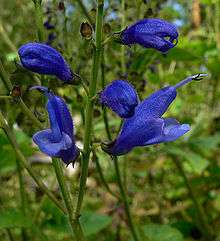Salvia cacaliifolia
| Salvia cacaliifolia | |
|---|---|
 | |
| Scientific classification | |
| Kingdom: | Plantae |
| (unranked): | Angiosperms |
| (unranked): | Eudicots |
| (unranked): | Asterids |
| Order: | Lamiales |
| Family: | Lamiaceae |
| Genus: | Salvia |
| Species: | S. cacaliifolia |
| Binomial name | |
| Salvia cacaliifolia Benth. | |
Salvia cacaliifolia (blue vine sage or Guatemalan sage) is a species of flowering plant in the family Lamiaceae, native to the mountains of Chiapas, Mexico, and in Guatemala and Honduras, at 1,500–2,500 m (4,921–8,202 ft) elevation. It has been available in the United Kingdom for many years, after being recognized by William Robinson in 1933. Since the 1970s, it has been available in the United States, after Strybing Arboretum and Huntington Botanical Gardens introduced it to California growers.
Nomenclature
The specific epithet is sometimes spelt cacaliaefolia in the literature; however, cacaliifolia is accepted as the correct spelling.[1] It means "with leaves like Cacalia[2] (a genus which has been renamed).
Description
It is an herbaceous perennial, blooming from midsummer to autumn with many pure gentian-blue flowers, about .5 inches long, with small green calyces. The leaves are grass-green in color with many hairs. The creeping rootstock spreads easily, forming clumps that are easily divided.[3]
This plant has gained the Royal Horticultural Society's Award of Garden Merit.[4]
Notes
- ↑ "Salvia cacaliifolia". International Plant Names Index. Retrieved 3 July 2013.
- ↑ Harrison, Lorraine (2012). RHS Latin for gardeners. United Kingdom: Mitchell Beazley. p. 224. ISBN 9781845337315.
- ↑ Clebsch, Betsy; Barner, Carol D. (2003). The New Book of Salvias. Timber Press. p. 53. ISBN 978-0-88192-560-9.
- ↑ "RHS Plant Selector - Salvia cacaliifolia". Retrieved 3 July 2013.